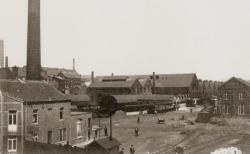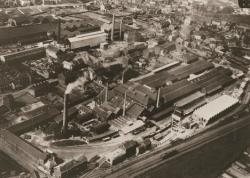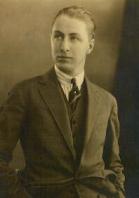1. Portrait of a man (1862 - 1934)
His family and industrial progress
On leaving university in 1886, Henri Lambert, an engineer like his father, had taken on the family glassworks. Typical of his character, he immediately undertook significant innovations that had the honour of being mentioned in the specialist press.
Witness: "We learn with pleasure that the continual glass melting furnace of Mr. Casimir Lambert, installed in the ‘Planche’ glass works, is now operational. The start-up has been splendid and the current operation continues to be brilliant and giving best results. This furnace has significant improvements over the continuous melting furnaces built until now, mainly due to the dimensions of the furnace. Until now, all ideas and tests were carried out for a great length of the furnace, and this, in order to arrive at a perfectly refined glass perfectly to be culled at the end ports. Henri Lambert realised that by some shortening of the length of the furnace, but increasing the width, the melting glass flow would have a slower advance, and so would arrive at the culling ports having melted the same number of hours in the furnace; in this way, a significant reduction in the cost of installation would be achieved. By this principle he calculated that the width of his furnace should be internally eight metres, with a length of fourteen. The conservation of the walls would also be better assured, providing a considerable benefit when it came to repairs.”
Differing views arose within the family. His sister, Aline, and especially her husband, Georges Despret, had their focus and interests elsewhere, and neither of his brothers, Florent and Paul, actively supported him. It was in a climate of years of simmering family tensions that at the very least paralyzed action and prevented the taking of urgent decisions, that must be found the genesis of "Barnum", his very own great new personal glassworks that he had built in 1901. Henri Lambert had no other choice, if he wanted to develop his activities, than to strike out on his own and forgo the family glassmaking heritage of his father and grandfather, Casimir Lambert. We therefore think that as soon as 1896, his father having died, Henri Lambert realised he had to consider leaving the family business, which he had fundamentally overhauled only a few years earlier, and go in search of a site for the construction of his new facility where he could finally realise his goals and ambitions. All this forced him to change course. The family enterprise of his father was therefore soon transferred to his father-in-law, Leon Mondron, an important glass master, and his wife, Valentine Lambert (a second cousin).
In 1900, "Barnum" arose in Lodelinsart (Charleroi). Its construction was financed by the inheritance Henri received after the death of his father.
Thus relieved of his obligations vis-à-vis the family business, Henri Lambert chose a lengthy site, in a hollow, along a creek in Lodelinsart, on the outskirts of Charleroi, on which to build his plant. Most of the project was carried out in 1901, but work began as early as April 1900. On February 12, 1902, in accordance with his economic ideas, especially in regard to their social and moral dimensions, he used his own money (his inheritance) to create, not a limited liability company (SARL), but a limited partnership, "Henri Lambert and Co.", of which he was the sole general partner. That is to say, he undertook all its management and assumed unlimited financial liability at the risk of his own funds. He was thus alone responsible to undertake its prudent and efficient management, aided by a very good and involved team, very low debt levels, and prudent growth.
The founding statutes reflected and embodied the entirety of Lambert’s thinking. They state that "Mr. Henri Lambert is the manager of the company and the only partner with unlimited liability. He alone is responsible for its management and the sole contractual signatory. The most extensive powers are given to him to manage and administer the company... “The management of the company will be for the lifetime of Mr. Lambert, in a purely personal capacity, and can never be divided or shared without the consent of the majority of partners.”
It appears from reading this act that it was indeed his work, a business in which he has all the powers, but also assumes all the responsibilities, having invested nearly all his assets in it. The design of the glass melting furnace, of great width, but also now of great length, more rational and therefore with greater efficiency and melting power, provided optimal conditions. With ample space and everything in line, both the furnace and the plant were very modern for their time. Most earlier glassworks had been gradually enlarged over time, their buildings erected around one or sometimes two furnaces of medium size, without much order, because sites were often too tight and did not lend themselves to rational use of space, and especially to achieving the best qualities and lowest production costs.
Getting the very large furnace started up was difficult: a strike was affecting glass making in Charleroi. The nearly 50 metres long furnace was not only the largest in the world, but, due to the homogenous quality of the melting, provided the best opportunity for high quality window glass (from blown cylinders). In 1903, in his work on "Glass in the twentieth century", Jules Henrivaux, a chemical engineer and former director of Saint-Gobain, wrote that "recently we were able to visit a new glassworks, in Charleroi (Belgium). This glassworks, built by Henri Lambert according to his own plans and under his direction, contains, we believe, the largest glass melting furnace on the Continent. The economical and efficient construction of this plant makes it in our opinion the most advanced of its type.” This comment of a foreign expert stands testimony to the reputation that the “Barnum” works rapidly acquired soon after its opening.
The business quickly became one of the most efficient glassworks in the world, if not the best. Its modern facilities attracted visits from authorities and engineers alike.
But a technological revolution was soon to take place, with the invention of vertical mechanical glass drawing by the Belgian engineer, Emile Fourcault, and somewhat later, the American Libby Owens horizontal process.
In April 1927, Henri Lambert announced his decision to turn his glass furnace into a large mechanical glass drawing facility. “M. Henri Lambert,” says a chronicler of the time, "is one of the few Belgian glassmakers who financially helped Fourcault to build the Dampremy Glassworks, which brought him, as well as other subscribers, certain advantages in regard to his own use of mechanical drawing. Until now, Mr. Lambert had refused to take advantage of this contract, for reason of honour. He felt duty bound not to abandon his workers, as long as the old process remained viable. But now the time has come. This is a landmark in the history of the glass industry because the plant in the hollow at Lodelinsart is the most modern and best equipped of the glass blowing works. This is the one that had the lowest cost. If the best can no longer remain viable, what is one to think of the rest? It was enough that the crisis continued to knock-out the old process, now that many mechanical furnaces were in operation. In this regard, Henri Lambert’s decision is symbolic.” At this point he adopted the Fourcault process – the last to do so. “This transformation of the equipment of one of the strongest Belgian glassworks represented a serious danger to the Fourcault Group," because Henri Lambert was an "independent industrialist and original economist who enjoyed a very justified reputation for Manchesterism and uncompromising economic liberalism." True to his conscience, he had refused to be part of a cartel and so led it a hard life. During its three years of existence (1927-1930), this cartel had to compete with the Libbey-Owens group, Henri Lambert, and the exporters.
In 1930, the situation was as follows: two Belgian groups of glassworks operating two different patents (the American Libbey Owens process and the Belgian Fourcault process, respectively 30% and 70% of Belgian capacity) but recently united by restrictive agreements. The Fourcault group now found itself "under the recent, but extensive control of the three largest banks and their subsidiaries, that is to say, three holding companies specifically created to control the Fourcault mechanical glass industry." Faced with this revolution, glass blowing works could no longer pull their weight. Only one large Fourcault independent resisted: Henri Lambert, whose powerful factory, "well equipped and with large financial resources, had continued to refuse to be taken over." The only one of the Belgian "Fourcault" units running, the “Barnum” plant had continued at full production and with profit, despite the deepening economic crisis.
Meanwhile in 1924, the family name "Lambert" became "Casimir-Lambert”.
The concentration Union of Mechanical Belgian Glassworks (UVMB or "Univerbel") in 1930.
The negotiations were tough, long and often interrupted. Throughout, Henri Lambert sought to keep his freedom. But he was subjected to intolerable pressures by the financiers, various threats, including the fomenting of social unrest and strikes fomented to bring his glassworks to a standstill.
The final and almost complete concentration of Belgian Fourcault glassworks was sought, in fact, by the financial groups to rescue their speculative investments in the mechanisation and take-over of many small and medium glass works from 1920 to 1928.
Finally, because of some (inadequate) improvements in his percentage of the “UVMB” and above all by the purchase at a good price by the three financial groups of a minority stake in his company (by now an LLC) Henri Lambert gave way! More aware than others of the socio-politico-economic disaster which would befall Europe in the later 1930s, of the great likelihood of another world war, of the entry of America into a depression, and of the threat of fascist and communist movements in Central and Eastern Europe, he had finally agreed to painful conditions. His son Valentin Casimir-Lambert (managing director) had fiercely refused, preferring to shut the plant down (threats of a strike) rather than give in. Henri Lambert had promised his son and only child, Valentin, not to give in. This was the origin of a great family drama between father and son.
The banks got what they wanted: the concentration of all plants using the Fourcault drawing process. This period had witnessed in Belgium a full industrial revolution characterised by consolidation among the glass producers, the creation of a common sales group, and finally, following the intervention of banks, the elimination of competition between producing companies. One can only guess how hard to take was the decision of Henri Lambert, extracted under pressure and by the use of threats, from a man who was fiercely independent and against any blow to free competition. All the more so because he saw himself thereby forced to renege on the promise he had made to his son never to give in.
Henri Lambert had brought the unifying industrial keystone to “UVMB”, and on becoming a Vice President, the only industrialist among financiers, while his management team (Georges Henry and his brother-in-law, Edgar Brichard, both brilliant engineers), would soon assume its general and technical management, and later that of “Glaverbel”, well after World War II.
What was he to do? Save his company, his work of a lifetime, from growing international risks, or stand to lose the confidence and attachment of his only son? This was a dramatic dilemma, the various consequences of which, as well as the subsequent economic disaster of “UVMB”, tarnished, alas, the last years of his life from 1930 to his death in 1934. Significant recovery had to wait until the years following World War II. Then, the merger of "Glaver" (plate glass and window glass) and "Univerbel" (advanced window glass) created the important Belgian glassmaking group "Glaverbel", still under the duo of Henri and Brichard, which had become a European and global flat glass leader, until a new disaster – that of the take-over of “Glaverbel” by BSN in 1972…
Last edited: 2021-07-02
Make a free website with emyspot - Signaler un contenu illicite sur ce site



